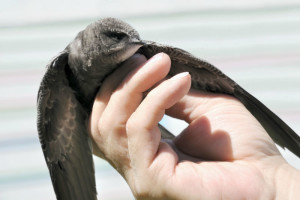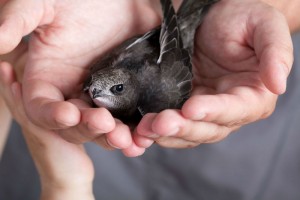So, you have chimney swifts in your chimney. The next questions may be, do they belong there and is it a big deal if they stick around? Chimney swifts may think your chimney is the perfect spot to set up camp, but the truth is that using a chimney that has chimney swifts and their nesting materials inside of it is unsafe for both you and the creatures themselves.
At Lords Chimney, we come across this issue from time to time, and we feel that it’s an important subject for our customers to understand. Learn more about these animals below, then keep reading to discover the best ways to keep them out of your chimney for good. Our expert team is ready to help you out!
What Is A Chimney Swift?
A chimney swift is a small bird that is known for its ability to stay in flight for extremely long periods of time. They’re typically darker in color with rounded heads, long and curved wings, and short beaks, tails, and necks. They eat all types of airborne insects and, as far as nesting and building homes, they favor steep, sheltered areas like hollow trees, caves, garages, air vents, and – you guessed it – chimneys.
Another thing to note about chimney swifts is that their population is in decline, which is why they are protected by the Migratory Bird Treaty Act. This means, once they settle in your chimney to raise young, there’s not a lot you can do about it. In fact, purposefully hurting these birds or removing a nest that may contain eggs or young could land you with some fines and/or penalties!
So, what can be done once a family of chimney swifts moves in? The truth is – nothing. All that is left to do at this point is wait until they migrate back down south, so you can remove their nesting materials and make your fireplace safer for regular use again. Unfortunately, it’s not uncommon for the birds to come back to the same spot again year after year, so it’s important to take action now to ensure they can’t get into your chimney next spring.
Taking Preventative Action
One thing that can be done to keep chimney swifts, as well as other woodland critters, out of your chimney for good is to have a chimney cap installed. Chimney caps cover your flue opening, so that animals cannot enter your chimney to build nests and raise young. This benefits both you and the animals! Your home will be a lot safer and more comfortable, and the animals won’t get stuck with no way out again.
The great thing about chimney caps is that they provide plenty of other benefits, as well. They ensure excess moisture stays out of your chimney and help prevent downdrafts, so you’re not stuck with a smokey living space night after night. They’ll also stop sparks from escaping the chimney, so they don’t risk landing on your flammable roofing materials. Achieving peace of mind has never been easier!
Ready for your new chimney cap? Call today to set up your appointment.
With spring just around the corner, many animals will begin looking for places to build their nests and lay their eggs. Unfortunately, some birds may view your chimney as the perfect nesting place for their young ones.
One animal that is well known for trying to nest in chimneys is the chimney swift – it’s even in their name! While it may not seem like a major problem, a chimney swift nest in your chimney can be a serious nuisance as they are a protected species that cannot be moved. The following information about chimney swifts can help homeowners recognize these birds, understand how they get into chimneys, and find ways to keep them out.

What are chimney swifts?
Chimney swifts are very small grey and brown birds with cigar shaped bodies and wide, short bills. Chimney swifts are easily identified by their distinctive chirp as well as their sharp, jerky movements when flying. While chimney swifts spend their non-breeding winters in South America, they migrate back to North America for the spring nesting season each year. According to the Cornell Lab of Ornithology , “Their ability to travel over long distances and through a variety of habitats exposes them to a wide range of microorganisms.”
Why chimney swifts love to nest in chimneys
In year’s past, chimney swifts preferred to nest in hollow or dead trees. However, as cities have grown larger and wooded areas are harder to find, chimney swifts have been forced to adapt. In fact, chimney swifts got their name because they often seek out chimneys as their nesting sites.
Chimney swifts most commonly find their way into uncapped chimneys or chimneys with damaged chimney caps. Because they are so small, even the smallest hole in the netting or mesh of a chimney cap can be big enough for a tiny swift to fit through. Because they are a migratory bird that will return year after year to the same nesting site, it is important to have your chimney repaired as soon as the swifts have left to avoid their return.
I have swifts in my chimney – now what?
When you first discover an animal has nested in your chimney, the natural reaction is to want them removed as soon as possible. Unfortunately, chimney swifts are a protected species whose nests cannot be moved.
Chimney swifts, along with a variety of other migratory birds, are protected by the Federal Migratory Bird Treaty Act. This law bans the removal or destruction of any migratory bird nests that have eggs or hatchlings. Thankfully for homeowners, chimney swifts have a short nesting cycle; in the span of about six weeks, the birds will nest, lay and hatch eggs, and have their hatchlings leave the nest.
While chimney swifts are a nuisance, they are a protected species that cannot be removed once they have built their nests. Because of this, they best way to keep them out is by preventative measures like spark arrestors or netting. For more information on chimney swifts and how to keep them out of your chimney this year, contact Lords Chimney today!
Spring has officially arrived, and with the warmer temperatures and longer days come new babies for many different kinds of animals. Unfortunately, many birds and small mammals may view your chimney as the perfect place to build a nest and raise their young. While many animals and their nests can be safely and humanely removed if they get into your chimney, one cannot: the chimney swift.

About chimney swifts
A chimney swift can be recognized by their size, color, movements, and sounds. Chimney swifts are small birds with narrow bodies and long wings. While up close they are a brown-gray color, they may appear black when backlit against the sky. Swifts fly and twist side to side erratically, and have a distinct high pitched chirp.
Although chimney swifts spend their winters in South America, they migrate north to the eastern United States and Canada each spring to nest and raise their young. According to the Cornell Lab of Ornithology, “Their ability to travel over long distances and through a variety of habitats exposes them to a wide range of microorganisms.”
Chimney swifts got their name because of their unique ability to build nests that stick to the side of slippery flue tiles. While swifts traditionally prefer to nest in hollow or dead trees, the increase in size of cities, suburbs, and agricultural areas has forced them to adapt.
Removing chimney swifts
If birds take up residence in your chimney, your first reaction may be to have them removed as soon as possible. Unfortunately for many homeowners, chimney swifts and several other species of migratory bird are protected under the Federal Migratory Birth Treaty Act. This law makes it illegal for anyone to remove or destroy chimney swift nests, eggs, or hatchlings, with severe fines and penalties for anyone who violates the law.
Luckily for those dealing with an unexpected nest of chimney swifts, the birds have a relatively short nesting period. Chimney swifts can lay, hatch, and raise their young in about six weeks. Likewise, as they nest in the spring and summer when fireplaces are not typically in use, the presence of a chimney swift nest of often little more than a minor inconvenience.
Keeping chimney swifts out
Because chimney swifts cannot be removed once they have taken up residence in your chimney, the best thing homeowners can do to prevent them is to have their chimney regularly inspected. A chimney inspection can ensure that there are no areas for chimney swifts to enter through, such as a damaged chimney cap.
Likewise, because chimney swifts are migratory they tend to return to the same nesting ground each year. Because of this, if you have chimney swifts find their way into your chimney it is extremely important to have the chimney inspected and repaired after they leave. If not, you may find that your chimney becomes an annual summer home for a family of chimney swifts.
If you think you have birds in your chimney, contact Lord’s Chimney today. Our expert technicians will be able to find out if they can be removed as well as help prevent them from getting in again.



